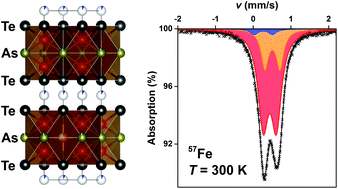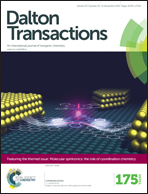New Fe-based layered telluride Fe3−δAs1−yTe2: synthesis, crystal structure and physical properties†
Abstract
A new ternary telluride, Fe3−δAs1−yTe2, was synthesized from elements at 600 °C. It crystallizes in the hexagonal P63/mmc space group with the unit cell parameters a = 3.85091(9) Å and c = 17.1367(4) Å for δ = 0.3 and y = 0.04. Its layered crystal structure contains partially occupied intralayer and interlayer Fe positions, which give rise to significant nonstoichiometry: Fe3−δAs1−yTe2 was found to possess the homogeneity range of 0.25 < δ < 0.45 and y = 0.04. Regions of local vacancy ordering alternate with regions of randomly distributed vacancies, so that the ordering of Fe atoms and vacancies is not complete in the average structure. Clear evidence of the magnetic phase transition is obtained by thermodynamic measurements, Mössbauer spectroscopy, and neutron powder diffraction. Magnetic susceptibility measurements reveal weak ferromagnetism below TC = 123 K with a net moment of MS ∼ 0.1μB/Fe at T = 2 K. This transition is confirmed by differential scanning calorimetry. Additionally, neutron powder diffraction indicates the onset of a complex AFM-like magnetic ordering below 100 K.



 Please wait while we load your content...
Please wait while we load your content...